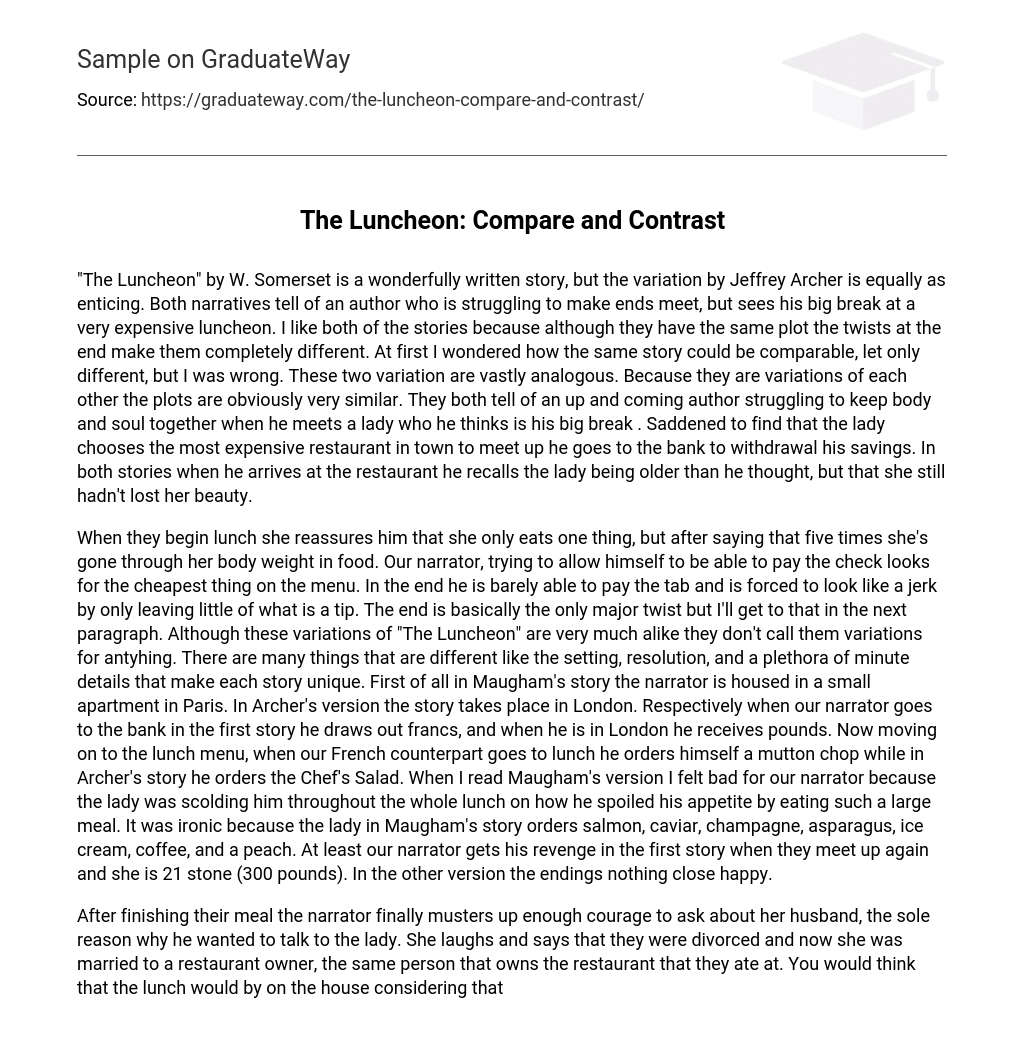“The Luncheon” by W. Somerset is a wonderfully written story, but the variation by Jeffrey Archer is equally as enticing. Both narratives tell of an author who is struggling to make ends meet, but sees his big break at a very expensive luncheon. I like both of the stories because although they have the same plot the twists at the end make them completely different. At first I wondered how the same story could be comparable, let only different, but I was wrong. These two variation are vastly analogous. Because they are variations of each other the plots are obviously very similar. They both tell of an up and coming author struggling to keep body and soul together when he meets a lady who he thinks is his big break . Saddened to find that the lady chooses the most expensive restaurant in town to meet up he goes to the bank to withdrawal his savings. In both stories when he arrives at the restaurant he recalls the lady being older than he thought, but that she still hadn’t lost her beauty.
When they begin lunch she reassures him that she only eats one thing, but after saying that five times she’s gone through her body weight in food. Our narrator, trying to allow himself to be able to pay the check looks for the cheapest thing on the menu. In the end he is barely able to pay the tab and is forced to look like a jerk by only leaving little of what is a tip. The end is basically the only major twist but I’ll get to that in the next paragraph. Although these variations of “The Luncheon” are very much alike they don’t call them variations for antyhing. There are many things that are different like the setting, resolution, and a plethora of minute details that make each story unique. First of all in Maugham’s story the narrator is housed in a small apartment in Paris. In Archer’s version the story takes place in London. Respectively when our narrator goes to the bank in the first story he draws out francs, and when he is in London he receives pounds. Now moving on to the lunch menu, when our French counterpart goes to lunch he orders himself a mutton chop while in Archer’s story he orders the Chef’s Salad. When I read Maugham’s version I felt bad for our narrator because the lady was scolding him throughout the whole lunch on how he spoiled his appetite by eating such a large meal. It was ironic because the lady in Maugham’s story orders salmon, caviar, champagne, asparagus, ice cream, coffee, and a peach. At least our narrator gets his revenge in the first story when they meet up again and she is 21 stone (300 pounds). In the other version the endings nothing close happy.
After finishing their meal the narrator finally musters up enough courage to ask about her husband, the sole reason why he wanted to talk to the lady. She laughs and says that they were divorced and now she was married to a restaurant owner, the same person that owns the restaurant that they ate at. You would think that the lunch would by on the house considering that it was the husband’s restaurant. Sadly though she drives off in her Rolls Royce leaving him with no money and no ride home. As you can see the two stories are very much alike, yet so different. Although they share a title their plots are very much unlike. When you read W. Somerset Maugham’s version it’s obvious that it was written much earlier than Archer’s. With its olden text and archaic words it’s definitely a fleeting style of writing, but just like a good cheese, the older the better. On the other hand there is the reborn version of the classic, some would say that it’s just a copy, but others retort to say that the latest is the greatest. I have my favorite but read them for yourself and you decide.





